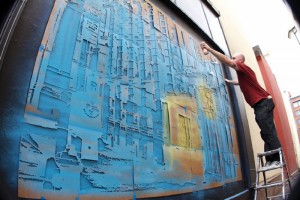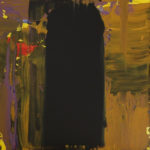Logan Hicks finds his place in the world one giant mural at a time

Logan Hicks, a spray can veteran from Baltimore based in New York for the past seven years, has an upcoming show at L.A.C.E in Los Angeles entitled Thin Veils and Heavy Anchors.
An artistic and meticulous kid, Logan worked in a screen-printing shop in high school and then went to art school in Baltimore, specializing in graphic design. But he quickly became stifled and distressed with Academia Art.
He says, the 90s, it was all very elitist and gallery based, so he put his skills to more practical use by opening his own screen-printing business. I actually made a lot of money selling t-shirts and totes till I made enough money to move to L.A and start painting full time. In a city where so many dreams and aspirations get crushed, Logan was a lucky thriver: funny, I guess I never had your regular 9-5 menial job, I went from working for myself to making a living with art.
Logan made his first stencil in 1999, and focused on mastering that medium. Any jackass with a razor and some cardboard can make a stencil, but you have to transcend the medium in order to make the image powerful. I will always want to transcend whatever medium I’m working with, and that’s why I’ve stuck to stencils till now. And it takes patience and time, a whole lot of time. He referred specifically to a stencil of his that is 13 by 15 feet and has 7 layers: In order to complete that I worked every day for twelve hours for three and a half weeks. He stays away from free-form graffiti but admires artists who can work with that spontaneous fluidity. It’s mind-blowing for me to see someone just start their project on the spot like that, with no sort of map. I’ve always been a methodical, linear thinker so stencils allow you to think.
After stenciling, traveling became his second passion, which is now an essential component of his art. I take cameras on all my trips and just take pictures of everything and use them and the memories they conjure to produce my art. Most of his pieces are reflections on the places he has been to. When I was living out West, I was making a lot of East coast art, using the gritty aesthetic urban complexes of Baltimore and New York. Being removed from those cities made them gleam in my mind as vivid pictures. I guess when you get enough distance you can see the full picture better. Many talented artists have shared this sentiment; even Hemingway said he could only write about Michigan when he was in Paris. Logan’s upcoming show in L.A. will feature works based in Paris and London. Traveling, and consequently my art, is about finding your place in the world whether it be metaphorical or geographical. Though his pieces are extremely detailed and structured, he describes them as a dream being remembered the next day [with an] effect fuzzy and surreal. The intricate cogs of everyday city life fascinate him, from subways to buildings, crowded streets and overpasses. In his art replete with bold reds, blues and black, whole cities are erected like giant haunting machines. Every place he goes is new, cracking open another dreamy machine. When I asked him if he saw himself moving back West after this show, he expressed what many New Yorkers feel: I think about it all the time, but traveling must suffice for now, because once you’ve lived in New York you simply cannot fully move out of it ”you know what I’m talking about. I asked about his thoughts on street art migration into galleries and indoor spaces. Of course the beauty of outside murals is that they are democratic and uniting but there’s always going to be a sacrifice of quality when you’re working outdoors. Taking it to galleries allows me to put the utmost quality and time into my pieces so I get a lot out of that too. Democracy and coming together is very important to Logan. He has curated several shows in the past. Collaboration and cooperation are essential in any art form but graffiti and street art are changing every day, and vastly different depending on where it’s done. Indeed, street art depends on generating movement and keeping it fresh; street artists work within communities, and in turn their audience is usually very community oriented. Logan’s work breeds into and off community in a unique way. You can check out Logan’s work at: http://workhorsevisuals.com/new/




